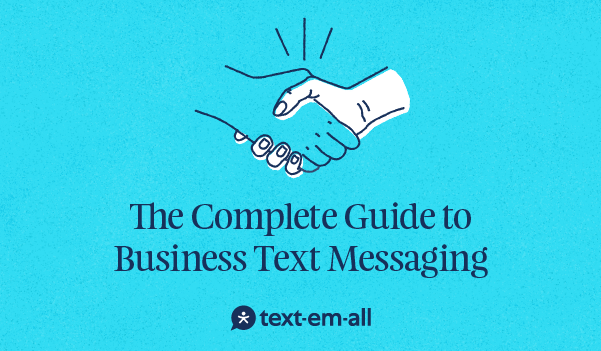
Business texting has transformed how organizations communicate with their customers, clients, and partners, and when done correctly, it can take a business to the next level.
This article explores the ins and outs of texting for business communication, from its practical applications to the compliance and best practices that ensure its effectiveness. By leveraging the power of text messages, businesses can streamline operations, enhance customer relationships, and achieve their communication goals effectively.
Table of Contents
The Benefits of Texting for Business Communication
12 Things to Keep in Mind for SMS Compliance
What is a Business Text?
A business text, or a business SMS (Short Message Service), refers to professional text messages exchanged between a company and its customers, clients, or partners. Unlike personal texts, which are often very casual, business texts are purpose-driven and strategically employed by organizations to achieve specific objectives.
Text messaging in business communication can be used in various ways, including mass texting, two-way texting, and automated responses. Since text messages boast an impressive 98% open rate, it is a powerful tool to engage with clients, streamline operations, and foster meaningful interactions.
Business SMS Use Cases
Business SMS can be a powerful tool for companies of all sizes. From enhancing customer communication to optimizing internal operations, here are a few ways businesses use text messaging to drive efficiency, engagement, and growth.
SMS Surveys
Sending out a survey via text is a great way to conduct research for a new product or service or simply get feedback on how your business is performing. You can easily ask your customers to complete a survey through text by sending a link to an external survey or creating a survey within your mass texting platform.
As a best practice, keep your text survey simple and quick to complete to increase the probability that your customers will respond to your request.
Customer reviews
One of the keys to attracting and converting new customers is receiving and showcasing positive reviews. Only a small percentage of customers leave reviews, but businesses can easily gain more reviews by sending a quick text to customers encouraging them to review their business.
Auto-replies
Using auto-replies with your mass texting software is an easy way to keep your contacts informed, even when you’re not by the phone. These automatic responses can tell them when you'll be back, when to call you instead, or if the number has changed. Plus, keyword-based auto-replies can give the sender information specific to their inquiry, making things more efficient for you.
Appointment Reminders
Healthcare providers, service professionals, and businesses with appointments benefit from text reminders, reducing no-show rates and improving operational efficiency.
Customer Feedback
Texting can be used to collect feedback and conduct surveys, providing valuable insights into customer satisfaction and preferences.
Emergency Notifications
In emergencies or critical updates, text message alerts are an effective way to inform employees or customers quickly.
8 Benefits of Texting for Business Communication
Texting offers a wide range of benefits for business communication, making it a valuable tool for organizations of all sizes and industries. Here are some key advantages:
1. Instantaneous Communication
Texting provides a near-instant way to reach customers or colleagues, ensuring that important messages are delivered and received promptly.
2. High Open Rates
Text messages have exceptionally high open rates, which ensures your messages are more likely to be seen than emails or other communication methods.
3. Convenience
Texting is convenient for both businesses and customers. It allows for quick exchanges, reducing the need for time-consuming phone calls or lengthy email exchanges.
4. Easy Personalization
Businesses can personalize their text messages with the recipient’s name and tailor content to their preferences, creating a more engaging and customer-centric experience.
5. Enhanced Customer Engagement
Texting enables businesses to engage with customers on their preferred channel, making building and maintaining relationships easier.
6. Improved Opt-In Engagement
Customers typically opt-in to receive business texts, ensuring you communicate with an interested audience.
7. Improved Customer Service
Businesses can provide efficient and responsive customer service through text messaging, addressing inquiries, and resolving real-time issues.
8. High Deliverability
Text messages are less likely to end up in spam folders than emails, ensuring that important information reaches its intended recipient.
How Mass Texting Works
The basic idea of mass texting is simple: you’re essentially sending the same message to a large group of recipients at once. With the right provider, businesses can leverage a robust and controlled method designed to help them personalize the message for certain segments of their audience, manage opt-ins and opt-outs, and measure the impact and reach of their messages. Here’s what you need to know about how it works.
Step 1: Decide what type of number you need
The first step to sending effective mass texting for business communication is to decide what type of number to use. Some services will help you figure out what type of number you need, but if they give you a choice, it’s a good idea to have an answer ready since registering a number can take time.
Short Code
This is a 4 to 9 digit phone number and is most commonly used to send:
- Shipping status updates
- Reminders
- SMS marketing messages
Having a short code number can be expensive, depending on how many messages businesses are sending and the data rates of your network provider. Texts sent via a shortcode are most commonly mass texts or bulk messages and are not usually suitable for two-way communication.
Long Code
A long code is a standard 10-digit number and is commonly used to send and receive two-way communication. For example, text messages directly to customers from customer support.
The disadvantage of a long code is that it must be registered to send business communication, and the registration process can sometimes take a long time. The customer support specialists at the mass texting service you choose should be able to help you get registered as fast as possible.
If you’re still unsure which phone number type you need, be sure to read up on long codes vs. short codes to understand which is the better option for your business.
Toll-Free Phone Numbers
Toll-free numbers, like long codes, are ten-digit phone numbers that can be used for mass texting. However, they are generally seen as more professional than long codes. Toll-free numbers are a great way to connect with your contacts by offering a familiar and accessible way for customers to respond.
Step 2: Sign up for a mass text messaging platform
The next step to sending a mass text is to sign up for a mass text messaging platform or service provider. These platforms offer features like contact management, scheduling, and analytics to streamline campaigns. Other features these platforms offer, like automation and personalization, can help you save time while communicating with customers.
Step 3: Write your message
Business texting is very different from writing a personal text message on your phone. Typically, you compose messages via the SMS platform on your desktop rather than from your mobile phone. Common options include writing the message yourself or using customizable text message templates.
Once you have drafted your message, you can opt to personalize specific fields of the message, such as name or appointment time. Customization features will be integrated into the platform and easy to use. You can paste each customer's name and phone number from your clipboard or import an Excel sheet with all the relevant information.
12 Things to Keep in Mind for SMS Compliance
One of the most important things to remember when sending business communication is that you should only send messages your contacts want to receive. Business texting becomes problematic when companies use a text messaging service to SPAM their customers for SMS marketing or cold sales.
We've all been on the receiving end of unwanted messages from businesses self-promoting, soliciting sales, promoting political agendas, or asking for charitable donations. This practice often leaves people feeling harassed and hostile to your outreach.
While these types of mass messages are not illegal, there are very specific rules businesses must follow to maintain compliance with regulatory bodies like the FCC (Federal Communications Commission) and FTC (Federal Trade Commission).
Follow these SMS Compliance rules and best practices to reduce frustrated opt-outs and ensure your messages are compliant.
- Ensure a legitimate reason exists for sending the text.
- Sign-off with your business name to identify the message sender.
- Make the information clear and easy to interpret.
- State any call to action clearly.
- Avoid slang and informal language.
- Prevent the message from appearing as spam or a sales pitch.
- Refrain from using abbreviations.
- Eliminate typos.
- Provide a straightforward way to contact customer support.
- Avoid sending the same message across multiple platforms.
- Offer customers the option to opt-out of receiving your texts.
- Double-check that all information is correct.
Mastering the Art of Business Text Messaging
Business texting is a versatile and efficient communication tool that empowers organizations to engage with their audience effectively. By understanding its applications, benefits, and best practices, businesses can harness the potential of text messaging to enhance communication, improve customer relationships, and achieve their goals in today's dynamic digital landscape.
Ready to give it a try? Set up a free Text-Em-All account to explore how your business can leverage texting for your business communication.












